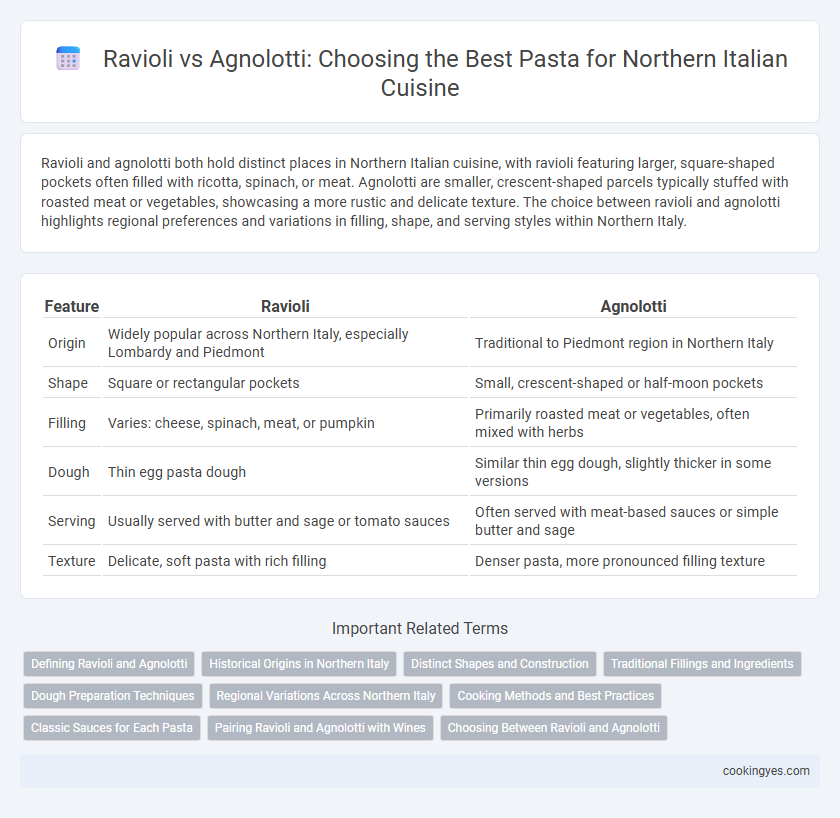Ravioli and agnolotti both hold distinct places in Northern Italian cuisine, with ravioli featuring larger, square-shaped pockets often filled with ricotta, spinach, or meat. Agnolotti are smaller, crescent-shaped parcels typically stuffed with roasted meat or vegetables, showcasing a more rustic and delicate texture. The choice between ravioli and agnolotti highlights regional preferences and variations in filling, shape, and serving styles within Northern Italy.
Table of Comparison
| Feature | Ravioli | Agnolotti |
|---|---|---|
| Origin | Widely popular across Northern Italy, especially Lombardy and Piedmont | Traditional to Piedmont region in Northern Italy |
| Shape | Square or rectangular pockets | Small, crescent-shaped or half-moon pockets |
| Filling | Varies: cheese, spinach, meat, or pumpkin | Primarily roasted meat or vegetables, often mixed with herbs |
| Dough | Thin egg pasta dough | Similar thin egg dough, slightly thicker in some versions |
| Serving | Usually served with butter and sage or tomato sauces | Often served with meat-based sauces or simple butter and sage |
| Texture | Delicate, soft pasta with rich filling | Denser pasta, more pronounced filling texture |
Defining Ravioli and Agnolotti
Ravioli are square or circular pasta pockets traditionally filled with a mixture of cheese, meat, or vegetables, often associated with regions like Emilia-Romagna in Northern Italy. Agnolotti, originating from Piedmont, are smaller, half-moon shaped dumplings typically stuffed with roasted meat or vegetables and resemble folded ribbons. Both ravioli and agnolotti showcase Northern Italian culinary artistry, yet differ in shape, filling styles, and regional preparation techniques.
Historical Origins in Northern Italy
Ravioli and agnolotti both originate from Northern Italy but showcase distinct historical roots tied to different regions. Ravioli, traditionally linked to Liguria and Tuscany, dates back to the Renaissance, characterized by square or circular pasta parcels filled with cheese, meat, or vegetables. Agnolotti, native to Piedmont, emerged in the 19th century as a smaller, crescent-shaped stuffed pasta reflecting local agricultural practices and seasonal ingredients.
Distinct Shapes and Construction
Ravioli in Northern Italian cuisine are typically square or rectangular with a uniform, pillow-like shape, created by sandwiching the filling between two sheets of pasta dough and sealing the edges. Agnolotti often feature a crescent or half-moon shape, formed by folding a single pasta sheet over the filling and pinching the edges to create a tighter, more compact pocket. The differences in shapes affect texture and cooking time, with ravioli offering a broader surface area and agnolotti providing a thicker, meatier bite.
Traditional Fillings and Ingredients
Ravioli and Agnolotti are both traditional Northern Italian stuffed pastas distinguished by their unique fillings and ingredients. Ravioli typically feature fillings such as ricotta cheese, spinach, and nutmeg, often enhanced with Parmesan and eggs to create a creamy texture. Agnolotti, originating from Piedmont, traditionally include roasted meats, such as beef or veal, combined with herbs and sometimes vegetables like pumpkin or spinach, offering a richer and heartier flavor profile.
Dough Preparation Techniques
Ravioli dough in Northern Italian cuisine typically involves a higher hydration level and the inclusion of eggs, resulting in a smooth, elastic texture ideal for holding rich fillings. Agnolotti dough is often thinner and more delicate, made with less egg to emphasize a lighter bite that complements the subtle filling of meat or vegetables. Techniques for ravioli emphasize rolling the dough to a uniform thickness to prevent breaking during boiling, while agnolotti dough requires careful handling to maintain its delicate structure and ensure even cooking.
Regional Variations Across Northern Italy
Ravioli and Agnolotti represent distinct pasta traditions in Northern Italian cuisine, with ravioli prevalent in regions like Liguria and Lombardy, characterized by larger square or circular shapes filled with cheese or meat. Agnolotti, native to Piedmont, are smaller, half-moon shaped, often stuffed with roasted meats and herbs, reflecting local flavors. These regional variations highlight Northern Italy's diverse culinary heritage, emphasizing differences in shape, filling, and sauce pairings tied to local ingredients.
Cooking Methods and Best Practices
Ravioli and agnolotti, both staple pasta types in Northern Italian cuisine, differ in cooking methods and best practices due to their shapes and fillings. Ravioli, typically larger with more filling, require gentle boiling for 3-5 minutes to maintain their delicate structure and ensure even cooking without bursting. Agnolotti, smaller and often folded with thicker dough edges, benefit from slightly shorter boiling times, around 2-4 minutes, and are best served with light butter or sage sauces to highlight their rich, meaty fillings.
Classic Sauces for Each Pasta
Ravioli in Northern Italian cuisine pairs traditionally with rich butter and sage sauces or light tomato-based ragu that enhance its wide variety of fillings, from ricotta to spinach and meat. Agnolotti, often smaller and folded more tightly, suit robust, meat-based gravies or delicate broths that highlight their denser filling of roasted meats or seasonal vegetables. Classic pairings like sage butter for ravioli in Piemonte contrast with the hearty braised beef sauce favored for agnolotti during festive meals in the same region.
Pairing Ravioli and Agnolotti with Wines
Ravioli and Agnolotti, two traditional Northern Italian pasta varieties, pair exceptionally well with distinct wines that highlight their unique fillings and textures. Rich, meat-stuffed Agnolotti from Piedmont harmonize with Barolo or Barbera, whose bold tannins and acidity balance the savory flavors. In contrast, delicate cheese or vegetable-filled Ravioli match perfectly with lighter white wines like Gavi or Soave, enhancing the dish's subtle nuances without overpowering them.
Choosing Between Ravioli and Agnolotti
Ravioli offers a larger, square-shaped pasta with a variety of fillings, making it ideal for showcasing rich, hearty Northern Italian flavors like spinach and ricotta or meat ragu. Agnolotti, smaller and crescent-shaped, traditionally features finely minced meat or vegetable fillings, providing a delicate texture perfect for lighter broths or buttery sauces common in Piedmont and Lombardy. Selecting between ravioli and agnolotti depends on the desired sauce pairing and textural balance in Northern Italian dishes.
Ravioli vs Agnolotti for Northern Italian cuisine Infographic

 cookingyes.com
cookingyes.com